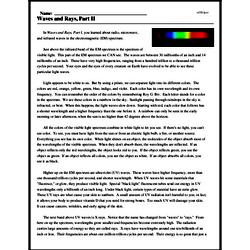Waves and Rays, Part II
In Waves and Rays, Part I, you learned about radio, microwave, and infrared waves in the electromagnetic (EM) spectrum.
Just above the infrared band of the EM spectrum is the spectrum of visible light. This part of the EM spectrum we CAN see. The waves are between 30 millionths of an inch and 14 millionths of an inch. These have very high frequencies, ranging from a hundred trillion to a thousand trillion cycles per second. Your eyes and the eyes of every creature on Earth have evolved to be able to see these particular light waves.
Light appears to be white to us. But by using a prism, we can separate light into its different colors. The colors are red, orange, yellow, green, blue, indigo, and violet. Each color has its own wavelength and its own frequency. You can remember the order of the colors by remembering Roy G. Biv. Each letter stands for a color in the spectrum. We see these colors in a rainbow in the sky. Sunlight passing through raindrops in the sky is refracted, or bent. When this happens, the light waves slow down. Starting with red, each color that follows has a shorter wavelength and a higher frequency than the one before it. A rainbow can only be seen in the early morning or later afternoon, when the sun is no higher than 42 degrees above the horizon.
All the colors of the visible light spectrum combine in white light to let you see. If there's no light, you can't see color. To see, you must have light from the sun or from an electric light bulb, a fire, or another source. Everything you see has its own color. When light shines on an object, the molecules of the object absorb most of the wavelengths of the visible spectrum. When they don't absorb them, the wavelengths are reflected. If an object reflects only the red wavelengths, the object looks red to you. If the object reflects green, you see the object as green. If an object reflects all colors, you see the object as white. If an object absorbs all colors, you see it as black.



